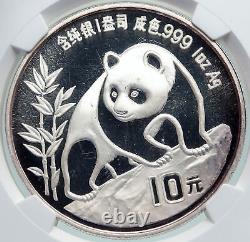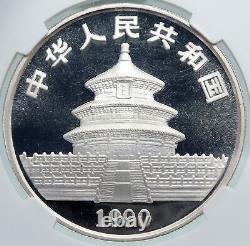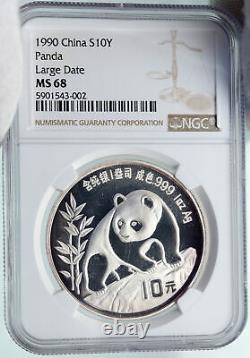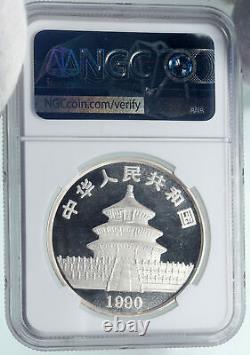1990 CHINA PANDA Bamboo TEMPLE of HEAVEN Silver 10 Yuan Chinese Coin NGC i87367







Item: i87367 Authentic Coin of. Republic - Panda Series 1990 Silver 10 Yuan 40mm (31.10 grams) 0.999 Silver 0.9989 oz.
MS 68 5901543-002 Reference: KM# 276, Y# 237 10? 999 1oz Ag, Panda with bamboo, value at left, weight and fineness below. The giant panda Ailuropoda melanoleuca, literally "black and white cat-foot"; Chinese:??? Pinyin: dà xióng mao, literally "big bear cat", also known as panda bear or simply panda, is a bear native to south central China.
It is easily recognized by the large, distinctive black patches around its eyes, over the ears, and across its round body. The name "giant panda" is sometimes used to distinguish it from the unrelated red panda. Though it belongs to the order Carnivora, the giant panda's diet is over 99% bamboo. Giant pandas in the wild will occasionally eat other grasses, wild tubers, or even meat in the form of birds, rodents, or carrion. In captivity, they may receive honey, eggs, fish, yams, shrub leaves, oranges, or bananas along with specially prepared food. The giant panda lives in a few mountain ranges in central China, mainly in Sichuan, but also in neighbouring Shaanxi and Gansu. As a result of farming, deforestation, and other development, the giant panda has been driven out of the lowland areas where it once lived.The giant panda is a conservation reliant vulnerable species. A 2007 report showed 239 pandas living in captivity inside China and another 27 outside the country. As of December 2014, 49 giant pandas lived in captivity outside China, living in 18 zoos in 13 different countries. Wild population estimates vary; one estimate shows that there are about 1,590 individuals living in the wild, while a 2006 study via DNA analysis estimated that this figure could be as high as 2,000 to 3,000. Some reports also show that the number of giant pandas in the wild is on the rise.
In March 2015, Mongabay stated that the wild giant panda population had increased by 268, or 16.8%, to 1,864. In 2016, the IUCN reclassified the species from "endangered" to "vulnerable". While the dragon has often served as China's national symbol, internationally the giant panda appears at least as commonly. As such, it is becoming widely used within China in international contexts, for example since 1982 issuing gold panda bullion coins or as one of the five Fuwa mascots of the Beijing Olympics.
The Temple of Heaven Chinese:?? Pinyin: Tiantán is an imperial complex of religious buildings situated in the southeastern part of central Beijing. The complex was visited by the Emperors of the Ming and Qing dynasties for annual ceremonies of prayer to Heaven for good harvest. It has been regarded as a Taoist temple, although Chinese heaven worship, especially by the reigning monarch of the day, predates Taoism. The temple complex was constructed from 1406 to 1420 during the reign of the Yongle Emperor, who was also responsible for the construction of the Forbidden City in Beijing.
The complex was extended and renamed Temple of Heaven during the reign of the Jiajing Emperor in the 16th century. Jiajing also built three other prominent temples in Beijing, the Temple of the Sun?? In the east, the Temple of Earth??
In the north, and the Temple of Moon?? The Temple of Heaven was renovated in the 18th century under the Qianlong Emperor. By then, the state budget was insufficient, so this was the last large-scale renovation of the temple complex in imperial times. The temple was occupied by the Anglo-French Alliance during the Second Opium War. In 1900, during the Boxer Rebellion, the Eight Nation Alliance occupied the temple complex and turned it into the force's temporary command in Beijing, which lasted for one year.The occupation desecrated the temple and resulted in serious damage to the building complex and the garden. Robberies of temple artifacts by the Alliance were also reported. With the downfall of the Qing, the temple complex was left un-managed. The neglect of the temple complex led to the collapse of several halls in the following years. In 1914, Yuan Shikai, then President of the Republic of China, performed a Ming prayer ceremony at the temple, as part of an effort to have himself declared Emperor of China.
In 1918 the temple was turned into a park and for the first time open to the public. The Temple of Heaven was inscribed as a UNESCO World Heritage Site in 1998 and was described as a masterpiece of architecture and landscape design which simply and graphically illustrates a cosmogony of great importance for the evolution of one of the world's great civilizations... " as the "symbolic layout and design of the Temple of Heaven had a profound influence on architecture and planning in the Far East over many centuries. China, officially the People's Republic of China (PRC) since 1949, is a country in East Asia and the world's most populous country, with a population of around 1.404 billion.
Covering approximately 9,600,000 square kilometers (3,700,000 sq mi), it is the third- or fourth-largest country by total area, depending on the source consulted. Governed by the Communist Party of China, the state exercises jurisdiction over 22 provinces, five autonomous regions, four direct-controlled municipalities (Beijing, Tianjin, Shanghai, and Chongqing), and the special administrative regions of Hong Kong and Macau. China emerged as one of the world's earliest civilizations, in the fertile basin of the Yellow River in the North China Plain.
For millennia, China's political system was based on hereditary monarchies, or dynasties, beginning with the semi-legendary Xia dynasty in 21st century BCE. Since then, China has expanded, fractured, and re-unified numerous times.
In the 3rd century BCE, the Qin unified core China and established the first Chinese empire. The succeeding Han dynasty, which ruled from 206 BC until 220 AD, saw some of the most advanced technology at that time, including papermaking and the compass, along with agricultural and medical improvements. Tang culture spread widely in Asia, as the new maritime Silk Route brought traders to as far as Mesopotamia and Horn of Africa. Dynastic rule ended in 1912 with the Xinhai Revolution, when a republic replaced the Qing dynasty. The Chinese Civil War resulted in a division of territory in 1949, when the Communist Party of China established the People's Republic of China, a unitary one-party sovereign state on Mainland China, while the Kuomintang-led government retreated to the island of Taiwan.
The political status of Taiwan remains disputed. Since the introduction of economic reforms in 1978, China's economy has been one of the world's fastest-growing with annual growth rates consistently above 6 percent. As of 2016, it is the world's second-largest economy by nominal GDP and largest by purchasing power parity (PPP). China is also the world's largest exporter and second-largest importer of goods. China is a recognized nuclear weapons state and has the world's largest standing army and second-largest defense budget.
The PRC is a permanent member of the United Nations Security Council as it replaced the ROC in 1971, as well as an active global partner of ASEAN Plus mechanism. China is also a leading member of numerous formal and informal multilateral organizations, including the Shanghai Cooperation Organization (SCO), WTO, APEC, BRICS, the BCIM, and the G20.
China is a great power and a major regional power within Asia, and has been characterized as a potential superpower. World-renowned expert numismatist, enthusiast, author and dealer in authentic ancient Greek, ancient Roman, ancient Byzantine, world coins & more. Ilya Zlobin is an independent individual who has a passion for coin collecting, research and understanding the importance of the historical context and significance all coins and objects represent. Send me a message about this and I can update your invoice should you want this method.
Getting your order to you, quickly and securely is a top priority and is taken seriously here. Great care is taken in packaging and mailing every item securely and quickly. What is a certificate of authenticity and what guarantees do you give that the item is authentic?
You will be very happy with what you get with the COA; a professional presentation of the coin, with all of the relevant information and a picture of the coin you saw in the listing. Additionally, the coin is inside it's own protective coin flip (holder), with a 2x2 inch description of the coin matching the individual number on the COA. Whether your goal is to collect or give the item as a gift, coins presented like this could be more prized and valued higher than items that were not given such care and attention to.When should I leave feedback? Please don't leave any negative feedbacks, as it happens sometimes that people rush to leave feedback before letting sufficient time for their order to arrive. The matter of fact is that any issues can be resolved, as reputation is most important to me. My goal is to provide superior products and quality of service.
How and where do I learn more about collecting ancient coins? Visit the Guide on How to Use My Store. For on an overview about using my store, with additional information and links to all other parts of my store which may include educational information on topics you are looking for.
This item is in the category "Coins & Paper Money\Coins: World\Asia\China\PRC (1949-Now)". The seller is "highrating_lowprice" and is located in this country: US.This item can be shipped worldwide.
- Country/Region of Manufacture: China
- Certification Number: 5901543-002
- Certification: NGC
- Grade: MS 68
- Year: 1990
- Circulated/Uncirculated: Uncirculated
- Composition: Silver
- Denomination: 10 Yuan


